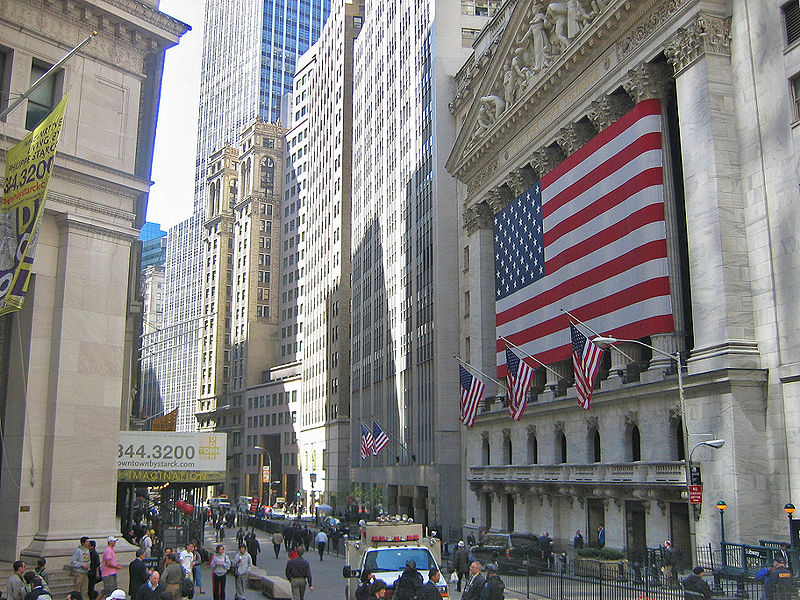New York Stock Exchange (NYSE)
Wall Street New York City
Welcome to our New York City Photo Gallery. The New York Stock Exchange on Wall Street is the largest stock exchange in the world by dollar volume.
|
1 : 2 : 3 : 4 : 5 : 6 : 7 : 8 : 9 : 10 : 11 : 12 : 13 : 14 : 15 |
Home > New York State Photographs > New York Stock Exchange
The New York Stock Exchange (NYSE, nicknamed "The Big Board") is an American stock exchange in the Financial District of Lower Manhattan in New York City. It is by far the world's largest stock exchange by market capitalization of its listed companies at US$30.1 trillion as of February 2018. The average daily trading value was approximately US$169 billion in 2013. The NYSE trading floor is at the New York Stock Exchange Building on 11 Wall Street and 18 Broad Street and is a National Historic Landmark. An additional trading room, at 30 Broad Street, was closed in February 2007.
The NYSE is owned by Intercontinental Exchange, an American holding company that it also lists (NYSE: ICE). Previously, it was part of NYSE Euronext (NYX), which was formed by the NYSE's 2007 merger with Euronext.
History
The earliest recorded organization of securities trading in New York among brokers directly dealing with each other can be traced to the Buttonwood Agreement. Previously, securities exchange had been intermediated by the auctioneers, who also conducted more mundane auctions of commodities such as wheat and tobacco. On May 17, 1792, twenty four brokers signed the Buttonwood Agreement, which set a floor commission rate charged to clients and bound the signers to give preference to the other signers in securities sales. The earliest securities traded were mostly governmental securities such as War Bonds from the Revolutionary War and First Bank of the United States stock, although Bank of New York stock was a non-governmental security traded in the early days. The Bank of North America, along with the First Bank of the United States and the Bank of New York, were the first shares traded on the New York Stock Exchange.
In 1817, the stockbrokers of New York, operating under the Buttonwood Agreement, instituted new reforms and reorganized. After sending a delegation to Philadelphia to observe the organization of their board of brokers, restrictions on manipulative trading were adopted, as well as formal organs of governance. After re-forming as the New York Stock and Exchange Board, the broker organization began renting out space exclusively for securities trading, which previously had been taking place at the Tontine Coffee House. Several locations were used between 1817 and 1865, when the present location was adopted.
The invention of the electrical telegraph consolidated markets and New York's market rose to dominance over Philadelphia after weathering some market panics better than other alternatives. The Open Board of Stock Brokers was established in 1864 as a competitor to the NYSE. With 354 members, the Open Board of Stock Brokers rivaled the NYSE in membership (which had 533) "because it used a more modern, continuous trading system superior to the NYSE's twice-daily call sessions". The Open Board of Stock Brokers merged with the NYSE in 1869. Robert Wright of Bloomberg writes that the merger increased the NYSE's members as well as trading volume, as "several dozen regional exchanges were also competing with the NYSE for customers. Buyers, sellers and dealers all wanted to complete transactions as quickly and cheaply as technologically possible and that meant finding the markets with the most trading, or the greatest liquidity in today's parlance. Minimizing competition was essential to keep a large number of orders flowing, and the merger helped the NYSE maintain its reputation for providing superior liquidity." The Civil War greatly stimulated speculative securities trading in New York. By 1869, membership had to be capped, and has been sporadically increased since. The latter half of the nineteenth century saw rapid growth in securities trading.
Securities trade in the latter nineteenth and early twentieth centuries was prone to panics and crashes. Government regulation of securities trading was eventually seen as necessary, with arguably the most dramatic changes occurring in the 1930s after a major stock market crash precipitated the Great Depression. The NYSE has also imposed additional rules in response to shareholder protection controls, e.g. in 2012, the NYSE imposed rules restricting brokers from voting uninstructed shares.
The Stock Exchange Luncheon Club was situated on the seventh floor from 1898 until its closure in 2006........



